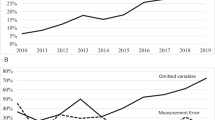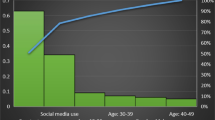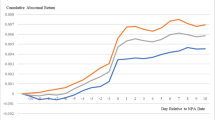Abstract
It is well-known that agents overreact to public information in markets characterized by strategic complementarities. We propose a simple and implementable method of alleviating the overreaction problem. Extending the beauty-contest game of Morris and Shin to a multi-region economy, we show that, under an aggregate information announcement, each agent converts purely public information into imperfect public information endogenously. This makes the agents’ beliefs dispersed and alleviates the overreaction problem. Moreover, we compare the welfare effect of the aggregate information announcement with that of a separate announcement. We find that there exist plausible situations where the aggregate information announcement is better than the separate information announcement despite reduced quality.
Similar content being viewed by others
References
Adam, K. (2007) “Optimal Monetary Policy with Imperfect Common Knowledge”, Journal of Monetary Economics, Vol. 54, pp. 267–301.
Allen, F., S. Morris and H. S. Shin (2006) “Beauty Contests and Iterated Expectations in Asset Markets”, Review of Financial Studies, Vol. 19, No. 3, pp. 719–752.
Amato, J. D. and H. S. Shin (2003) “Public and Private Information in Monetary Policy Models”, Discussion Paper, Bank of International Settlements and LSE.
Angeletos, G.-M. and J. La’O (2008) “Dispersed Information over the Business Cycle: Optimal Fiscal and Monetary Policy”, mimeo.
Angeletos, G.-M. and A. Pavan (2004) “Transparency of Information and Coordination in Economies with Investment Complementarities”, American Economic Review, Vol. 94, No. 2, pp. 91–98.
—— and —— (2007) “Efficient Use of Information and Social Value of Information”, Econometrica, Vol. 75, No. 4, pp. 1103–1142.
—— and —— (2009) “Policy with Dispersed Information”, Journal of the European Economic Association, Vol. 7, No. 1, pp. 11–60.
Arato, H. and T. Nakamura (2011) “The Benefit of Mixing Private Noise into Public Information in Beauty Contest Games”, The B.E. Journal of Theoretical Economics, Vol. 11, No. 1 (Contributions), article 8.
Chen, Q., T. Lewis and Y. Zhang (2012) “Clarity vs. Publicity in Disclosure of Public Information”, SSRN Working Paper Series. [Cited 7 November 2012.] Available from URL: http://ssrn.com/abstract=2005984
Colombo, L. and G. Femminis (2008) “Social Value of Information with Costly Information Acquisition”, Economics Letters, Vol. 100, No. 4, pp. 196–199.
Cornand, C. and F. Heinemann (2008) “Optimal Degree of Public Information Dissemination”, Economic Journal, Vol. 118, pp. 718–742.
Dewan, T. and D. P. Myatt (2008) “The Qualities of Leadership: Direction, Communication, and Obfuscation”, American Political Science Review, Vol. 102, No. 3, pp. 351–368.
—— and —— (2012) “On the Rhetorical Strategies of Leaders: Speaking Clearly, Standing Back, and Stepping Down”, Journal of Theoretical Politics, Vol. 24, pp. 431–460. doi: https://doi.org/10.1177/0951629811429006.
Heinemann, F. and G. Illing (2002) “Speculative Attacks: Unique Equilibrium and Transparency”, Journal of International Economics, Vol. 58, No. 2, pp. 429–450.
Hellwig, C. (2002) “Public Announcements, Adjustment Delays and the Business Cycle”, Working Paper, UCLA.
—— (2005) “Heterogeneous Information and the Welfare Effects of Public Information Disclosures”, Working Paper, UCLA.
Hellwig, C. and L. Veldkamp (2009) “Knowing What Others Know: Coordination Motives in Information Acquisition”, Review of Economic Studies, Vol. 76, No. 1, pp. 223–251.
James, J. and P. Lawler (2011) “Optimal Policy Intervention and the Social Value of Public Information”, American Economic Review, Vol. 101, No. 4, pp. 1561–1574.
Lindner, A. (2006) “Does Transparency of Central Banks Produce Multiple Equilibria on Currency Markets?”, Scandinavian Journal of Economics, Vol. 108, No. 1, pp. 1–14.
Lorenzoni, G. (2009) “Optimal Monetary Policy with Uncertain Fundamentals and Dispersed Information”, Review of Economic Studies, Vol. 77, No. 1, pp. 305–338.
Mackowiak, B. and M. Wiederholt (2009) “Optimal Sticky Prices under Rational Inattention”, American Economic Review, Vol. 99, No. 3, pp. 769–803.
Morris, S. and H. S. Shin (1998) “Unique Equilibrium in A Model of Self-Fulfilling Currency Attacks”, American Economic Review, Vol. 88, No. 3, pp. 587–597.
—— and —— (2001) “Global Games: Theory and Applications”, Cowles Foundation Discussion Paper, No. 1275R, Yale University.
—— and —— (2002) “Social Value of Public Information”, American Economic Review, Vol. 92, No. 5, pp. 1521–1534.
—— and —— (2007) “Optimal Communication”, Journal of the European Economic Association, Vol. 5, No. 2–3, pp. 594–602.
Morris, S., H. S. Shin and H. Tong (2006) “Social Value of Public Information: Morris and Shin (2002) Is Actually Pro-Transparency, Not Con: Reply”, American Economic Review, Vol. 96, No. 1, pp. 453–455.
Myatt, D. P. and C. Wallace (2010) “On the Sources and Value of Information: Public Announcements and Macroeconomic Performance”, mimeo.
—— and —— (2012) “Endogenous Information Acquisition in Coordination Games”, Review of Economic Studies, Vol. 79, No. 1, pp. 340–374.
Svensson, L. E. (2006) “Social Value of Public Information: Comment: Morris and Shin (2002) Is Actually Pro-Transparency, Not Con”, American Economic Review, Vol. 96, No. 1, pp. 453–455.
Ui, T. (2003) “A Note on the Lucas Model: Iterated Expectations and the Neutrality of Money”, Working Paper, Yokohama National University.
Author information
Authors and Affiliations
Additional information
We would like to thank the Co-editor, an anonymous referee, Junichiro Ishida, Ryuichiro Ishikawa, Makoto Saito, Tadashi Sekiguchi, Akihisa Shibata and Etsuro Shioji for helpful suggestions. We also thank participants of the Japanese Economic Association Spring Meeting 2011 at Kumamoto Gakuen University, and seminar participants at Hitotsubashi University, Fukuoka University, the Summer Workshop on Economic Theory, the Financial Economics Workshop and the Contract Theory Workshop for useful comments. Arato is grateful for financial support through a Grant-in-Aid for Research Activity Start-up (22830058) and for Young Scientists (B) (24730241). The views expressed in this paper are those of the authors and do not necessarily reflect the views of the Financial Services Agency.




